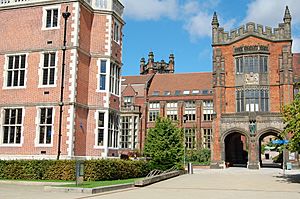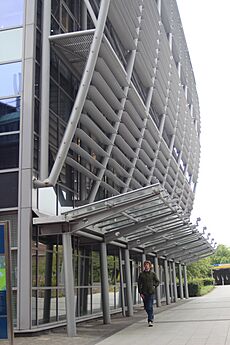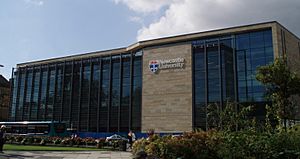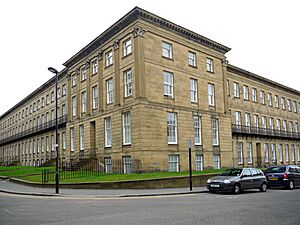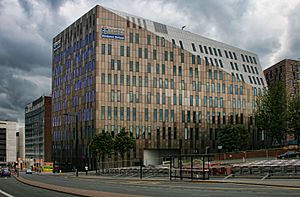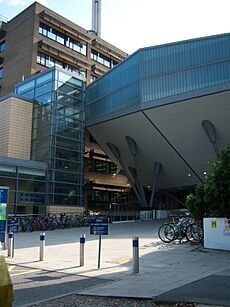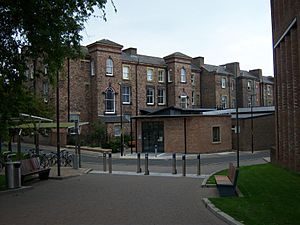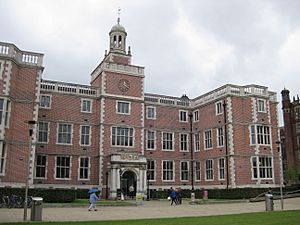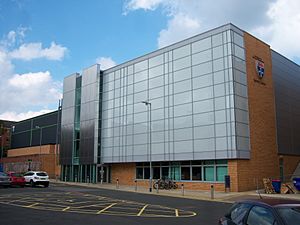Newcastle University facts for kids
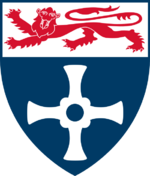 |
|
| Type | Public |
|---|---|
| Established | 1834 (as The Newcastle-upon-Tyne School of Medicine and Surgery) 1963 (as the University of Newcastle upon Tyne) |
| Endowment | £94.8 million (2024) |
| Budget | £619.8 million (2023/24) |
| Chancellor | Imtiaz Dharker |
| Vice-Chancellor | Chris Day |
|
Academic staff
|
3,030 (2023/24) |
|
Administrative staff
|
3,560 (2023/24) |
| Students | (2015/16) 26,330 FTE (2015/16) |
| Undergraduates | (2015/16) |
| Postgraduates | (2015/16) |
| Location |
,
England
54°58′41″N 1°36′54″W / 54.978°N 1.615°W |
| Campus | Urban |
| Colours | rich blue |
| Affiliations |
|
| Mascot | Percy the Lion |
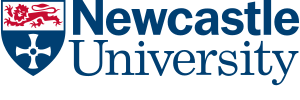 |
|
Newcastle University is a public university located in Newcastle upon Tyne, England. It is a place where students learn and researchers discover new things. The university also has campuses in Singapore and Malaysia. It is a member of the Russell Group, which is a group of top UK universities known for their excellent research.
The university's story began in 1834 with a School of Medicine and Surgery. Later, in 1871, the College of Physical Science was founded. These two colleges became part of the larger University of Durham. In 1937, the Newcastle colleges joined together to form King's College. Then, in 1963, King's College became the independent University of Newcastle upon Tyne.
Today, the university has three main parts, called faculties: Humanities and Social Sciences, Medical Sciences, and Science, Agriculture and Engineering. It offers many different study programs for both new students and those continuing their education. In the 2023–24 school year, the university's income was over £619 million, with a big part of that coming from research projects.
Contents
- University History: How it Started
- Exploring the University Campus
- How the University is Organized
- Student Life at Newcastle University
- Notable People from Newcastle University
- More to Explore
- See also
University History: How it Started
The idea of a university in Newcastle upon Tyne was first suggested in 1831. In 1832, a group of doctors started giving medical lectures. This led to the official opening of the School of Medicine and Surgery on October 1, 1834.
Later, in 1851, the school split into two groups because of disagreements. But they came back together in 1857. This medical college then became closely linked with the University of Durham.
In 1871, the College of Physical Science was created. This college taught subjects like maths, physics, and chemistry. It was important for the growing mining industry. This college was later renamed Armstrong College. Both the medical college and Armstrong College were part of the University of Durham.
Over time, the colleges in Newcastle grew much faster than those in Durham. This led to them becoming "King's College, Durham" in 1937. Finally, on August 1, 1963, the University of Newcastle upon Tyne became its own separate university.
In 1967, Newcastle University gave an honorary degree to Martin Luther King. This was a very special event.
In 2024, the university faced some financial challenges. To help with this, they offered a voluntary program for staff to leave their jobs.
Exploring the University Campus
The university's main campus is in the center of Newcastle upon Tyne. It's located near Haymarket and close to green spaces like Leazes Park. The university's medical school is also nearby.
Historic Buildings on Campus
The Armstrong Building is the oldest building on campus. It was built in stages, starting in 1888. The Jubilee Tower, part of this building, was funded by money raised from a celebration for Queen Victoria in 1887. Inside, the King's Hall is where important ceremonies, like graduations, take place. During the First World War, this building was used as a hospital for soldiers.
The University Quadrangle, next to the Armstrong Building, is a popular spot for graduation photos. In 1949, it became a garden to remember those from the university who lost their lives in the World Wars. A statue of Martin Luther King Jr. was placed here in 2017.
The Bruce Building, once a brewery, was refurbished in 2016 and now has student homes and offices.
Modern Campus Features
The Devonshire Building, opened in 2004, is designed to save energy. It uses solar panels and geothermal heating to control its temperature. This building has won awards for its design.
The King's Gate building, built in 2009, is a modern addition to the campus. It houses student and administrative services. In 2012, new buildings for INTO Newcastle University were completed, providing more teaching rooms and a learning center.
University Libraries
The main library is the Philip Robinson Library, named after a generous bookseller. The Walton Library focuses on medical sciences and is used by students and staff from the NHS. The Law Library has resources for law students. Together, these libraries hold over a million books and many online resources.
Besides the main campus, the university also has other locations like the Dove Marine Laboratory by the sea and Cockle Park Farm in Northumberland.
Campuses Around the World
In 2008, Newcastle University opened a campus in Singapore, which later became Newcastle University Singapore. In 2011, the Medical School opened another campus in Iskandar Puteri, Johor, Malaysia, called Newcastle University Medicine Malaysia.
Where Students Live
Newcastle University offers many halls of residence for first-year students. These are located around the city. Many students also choose to live in private houses or flats in areas like Jesmond and Heaton.
How the University is Organized
The head of the university is called the Chancellor. The current Chancellor is the poet and artist Imtiaz Dharker. The Vice-Chancellor, who manages the university day-to-day, is Chris Day.
The university has about 16,000 undergraduate students and 5,600 postgraduate students. Teaching and research happen in 19 academic schools and many research institutes. These are grouped into the three main faculties: Humanities and Social Sciences, Medical Sciences, and Science, Agriculture and Engineering.
University Leaders
Chancellors
- Hugh Percy, 10th Duke of Northumberland (1963–1988)
- Matthew White Ridley, 4th Viscount Ridley (1988–1999)
- Chris Patten (1999–2009)
- Liam Donaldson (2009–2019)
- Imtiaz Dharker (2020–)
Vice-Chancellors
- Charles Bosanquet (1963–1968)
- Henry Miller (1968–1976)
- Ewan Stafford Page (1976–1978, acting)
- Laurence Martin (1978–1990)
- Duncan Murchison (1991, acting)
- James Wright (1992–2000)
- Christopher Edwards (2001–2007)
- Chris Brink (2007–2016)
- Chris Day (2017–present)
University's Role in Society
The university sees itself as a "civic university." This means it uses its research to help solve problems in local, national, and international communities. For example, in 2012, it opened the Newcastle Institute for Social Renewal to study social and economic changes.
Since 2007, the campus has been smoke-free. The university also works closely with local museums, like the Great North Museum: Hancock.
Academic Departments and Research
The university's teaching schools are part of its three faculties. Each faculty has different schools and research institutes.
Faculty of Humanities and Social Sciences
- School of Architecture, Planning and Landscape
- School of Arts and Cultures
- Newcastle University Business School
- School of Education, Communication and Language Sciences
- School of English Literature, Language and Linguistics
- School of Geography, Politics and Sociology
- School of History, Classics and Archaeology
- Newcastle Law School
- School of Modern Languages
- School X
Faculty of Medical Sciences
- School of Biomedical, Nutritional and Sport Sciences
- School of Dental Sciences
- School of Medical Education
- School of Pharmacy
- School of Psychology
- Centre for Bacterial Cell Biology (CBCB)
Faculty of Science, Agriculture and Engineering
- School of Computing
- School of Engineering
- School of Mathematics, Statistics and Physics
- School of Natural and Environmental Sciences
Business School
The Newcastle University Business School is a "triple accredited" business school. This means it has been recognized by three major international organizations for its high quality. In 2011, the business school opened a new building next to St James' Park.
Medical School
The Medical School at Newcastle is highly regarded. A report in 2008 showed that medical graduates from Newcastle performed very well in postgraduate tests. The Royal Victoria Infirmary is a major teaching hospital closely linked to the Medical School.
School of Modern Languages
The School of Modern Languages teaches many languages, including Chinese, Japanese, French, German, Spanish, and Portuguese. Students learn not just the language but also about the cultures where they are spoken. The school also hosts special institutes for Portuguese and Chinese language and culture.
Newcastle Law School
Newcastle Law School is the oldest law school in the north-east of England. It has many experts in different areas of law. The Law School is located in several old town houses that have been specially adapted for teaching.
School of Computing
The School of Computing is ranked among the top 100 in the world. They do research in areas like how humans interact with computers, secure systems, and data science.
Cavitation Tunnel
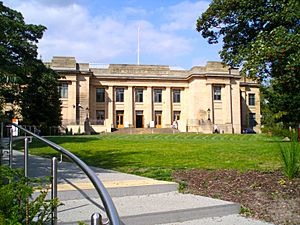
Newcastle University has the second largest cavitation tunnel in the UK. This tunnel is used to test things like propellers and underwater coatings. It helps scientists understand how things move through water.
Museums and Galleries
The university is connected to several museums and galleries in the region. This includes the Great North Museum, which is mainly based at the Hancock Museum. The university's Hatton Gallery is also part of this project.
Student Life at Newcastle University
Students' Union
The Newcastle University Students' Union (NUSU) is where students can join clubs and societies. The Union building was built in 1924 and is a historic building. It was refurbished in 2010.
The Students' Union is run by student officers. They help organize events and support student activities.
The Courier is the university's weekly student newspaper. It started in 1948 and is read by many students. It has won awards for being a top student publication.
Newcastle Student Radio is the university's radio station, playing music and talking about news and sports. NUTV is the student television channel, which creates live shows and student-made programs.
Student Exchange Programs
Newcastle University has agreements with over 100 universities in other countries. This allows students to study abroad for a while and experience different cultures.
Sports at Newcastle
Newcastle is one of the top universities for sports in the UK. It has over 50 student-led sports clubs. The university has excellent indoor and outdoor sports facilities.
The university has friendly sports rivalries with other local universities. They used to compete in the Stan Calvert Cup against Northumbria University. There's also The Boat Race of the North against Durham University's rowing clubs.
The university's Cochrane Park sports facility was used as a training venue for football teams during the 2012 London Olympics.
Notable People from Newcastle University
Many famous and successful people have studied or worked at Newcastle University.
More to Explore
- List of universities in the United Kingdom
- Rankings of universities in the United Kingdom
See also
 In Spanish: Universidad de Newcastle upon Tyne para niños
In Spanish: Universidad de Newcastle upon Tyne para niños



